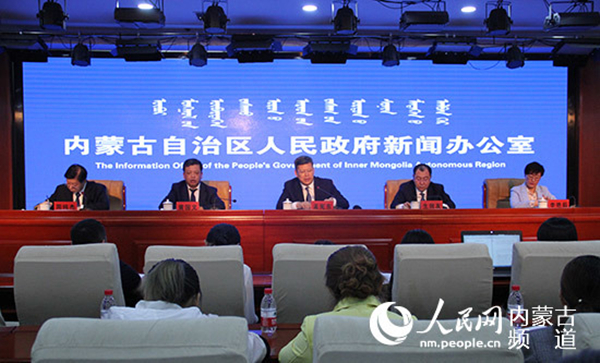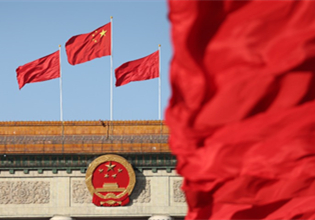Chifeng celebrates 70 years of glittering achievements

Local officials from Chifeng in North China's Inner Mongolia autonomous region highlight the great achievements made by the city over 70 years at a press conference in Hohhot, capital of the autonomous region, on Sept 10. [Photo/nm.people.cn]
The gross domestic product of Chifeng, a city located in the eastern part of North China's Inner Mongolia autonomous region, hit 154.98 billion yuan ($21.78 billion) last year, which was 703 times higher than its GDP of 220 million yuan in 1952, local officials told a press conference in Hohhot, the capital of the region, on Sept 10.
The news conference was part of a series of events being held in Inner Mongolia to report on the autonomous region's achievements over the past 70 years -- and to celebrate the 70th anniversary of the founding of the People's Republic of China.
According to the reports, Chifeng’s total fiscal revenue increased from 91.9 million yuan in 1982 to 195.3 billion yuan in 2018 and its comprehensive economic strength ranked it fourth in the region last year.
Officials said that through continuous industrial restructuring, Chifeng's industrial system has been continuously improved, its economic structure has been continuously upgraded -- and the comprehensiveness, coordination and sustainability of its economic development have been continuously enhanced.
The city's annual grain production capacity is stable at more than 5 billion kilograms, they added, with an annual vegetable output of 8 million tons.
The numbers of livestock have increased from 1.34 million head in 1982 to 14.11 million and it has become an important green agricultural and livestock product supply base for China, officials added.
The city’s industrial economy is developing rapidly, including the non-ferrous metallurgical industry and pharmaceutical industries, with respective output value last year reaching 100 billion yuan and 10 billion yuan.
In addition, Chifeng is continuing to speed up its development as a national clean energy export base -- and its new chemicals industry, electronic information, intelligent manufacturing and other emerging industries are also in the ascendant, officials said. The planned area of 129 square kilometers for Chifeng High-tech Zone has also become an industrial corridor for intensive development.
Chifeng's services industry has become the mainstay of the city's economy. In addition, traditional local trade, modern logistics, modern finance and tourism are helping push each other's development, according to officials. Last year, the city's total retail sales of consumer goods hit 81.1 billion yuan and the logistics industry realized sales income of 55 billion yuan.
In the banking sector, the balance of deposits and loans reached 231.04 billion yuan and 186.85 billion yuan, respectively, last year. The number of tourists received by Chifeng totaled 18.53 million yuan and tourism income came in at 30.6 billion yuan.
Officials said that by continuously promoting the transformation of traditional industries and cultivating emerging industries, the quality of Chifeng's economic development has improved significantly.
But the environment has also improved. Over the past 70 years, the forest coverage of Chifeng has increased from 5.2 percent to 35.7 percent, the vegetation coverage of natural grassland has reached 58.8 percent -- and the city’s arid, sandy areas have decreased from 2.67 million hectares to 1.88 million ha.
In addition, the number of days of good air quality in Chifeng increased from 280 days in 2014 to 331 days in 2018, making it the only city in the region that has continuously improved its air quality for continuous five years.
Moreover, Chifeng's urban construction has been upgraded in an all-round way and the urban and rural landscape has taken on a new look.
Officials said statistics showed that the green space rate of Chifeng’s central urban area reached 33.9 percent last year and the per capita area for green parks reached 19.2 square meters.
The built-up area of Chifeng's central urban area has expanded to 106 square kilometers and the population has increased to 1.268 million. It has become the third city with a population of over one million in the autonomous region.
Over the past 70 years, Chifeng has been accelerating its new urbanization and the urbanization rate of the city's permanent population has increased to 50.4 percent. Officials said that the integration of urban and rural development has proceeded. A total of 237,000 dangerous and clay buildings in rural and pastoral areas have been renovated and Chifeng has taken the lead in achieving full coverage television signals and network broadband in rural and pastoral areas.
They said the infrastructure construction of Chifeng has continuously improved. The roads in Chifeng have increased from 727 kilometers in the early period after the founding of the People's Republic of China to 27,000 km currently -- a growth rate of 36 times. The total length of expressways and first-class highways in Chifeng is now 1,549 km and more than 20,000 villages have asphalt roads.
Chifeng's rail lines have increased from 114 km in the early days of the founding of the People's Republic of China to 1,101 km, an increase of 8.7 times. The new Chifeng high-speed railway will start operations in 2020, integrating the city into the two-hour economy circle of Beijing and Shenyang in northeastern China's Liaoning province.
Last year, the per capita disposable income of urban and rural residents in Chifeng reached 31,931 yuan and 11,373 yuan respectively -- which were 279 times and 210 times higher than in the early days after the founding of the People's Republic of China.
Officials added that Chifeng has invested over 70 billion yuan and successfully helped 900,000 people out of poverty. In the city, the social security system has been established in an all-round way, with the participation rate in basic urban medical insurance now reaching 97 percent, while the registered unemployment rate in urban areas has been kept to within 4.5 percent.



 Print
Print Mail
Mail





